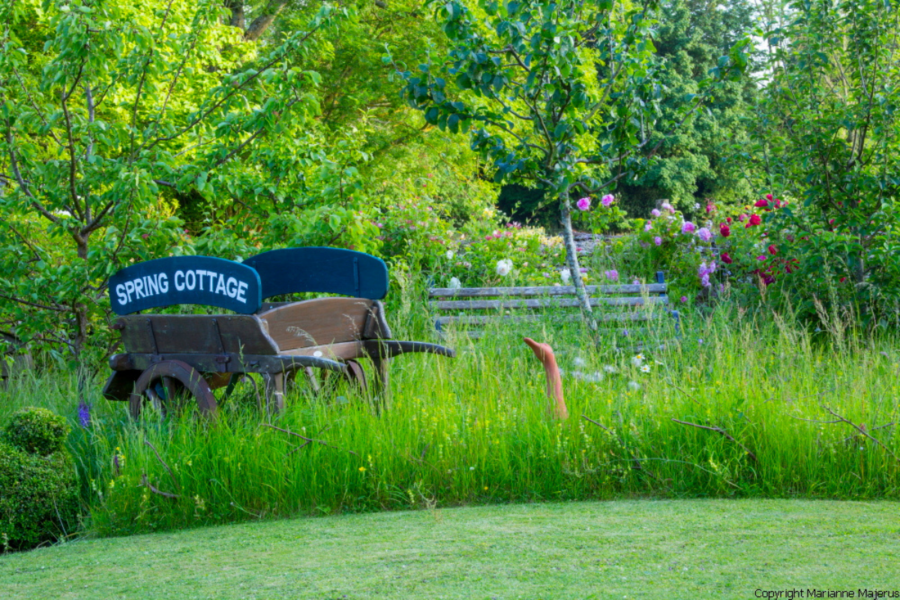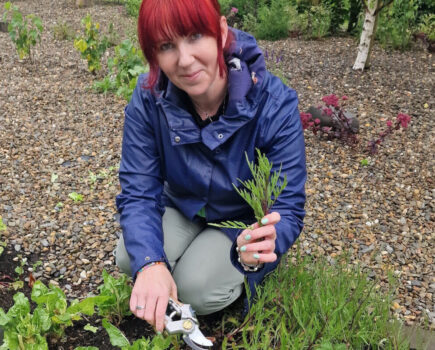Val explains how to create your own little patch of wildflower wonder
I don’t have a really enormous garden at Spring Cottage. It’s a third of an acre and one third of that is dedicated to fruit and vegetables. The large, rectangular stripy lawn has never been an option here, because there just isn’t enough room. Anyway, I am very keen on meadows and this is the perfect time to stand, stare and watch the many bees visiting mine. Soon I will have butterflies, for gardens with longer grass encourage many summer-flying beauties. I expect to see lolloping sooty ringlets, flighty skippers, vivid orange and brown gatekeepers and lots of meadow browns, although not necessarily in that order.
My mini-meadows are not large, sadly, and they are more in the style of horticultural meadows because they contain daffodils, camassias, cultivated orchids and an upland fritillaria, named F. pyrenaica. These bulbs self-seed among cowslips and other native flowers. I was inspired by King’s meadows at Highgrove House and I can remember one perfect May visit when silvery blue camassias rose above the sooty tulip ‘Queen of Night’. These pre-empted the many wild flowers.
I was also influenced by the National Trust. Some twenty years ago they were forced to rethink their mowing regime for purely financial reasons. They decided to leave most of the grass to grow and it worked visually, because they cut smart paths right through it. My mini meadows are surrounded by neatly-mown grass and this provides a sharp contrast and that makes it looks as though it’s meant to be there, not just neglected. The National Trust’s human visitors loved the new look, but so did the birds, bees and butterflies. They were drawn in by plants that had re-emerged from the seedbank, seeds that had lain dormant for decades. Others, like bugle or Ajuga reptans, were finally allowed to flower and please the bees.
Meadows like this are win-win
What had started as a financial cost-cutting exercise by the National Trust, had brought back wildlife and the public loved it. When I moved here in 2005, I had already been experimenting with meadows for five years or so, encouraged by what had I had learnt from Highgrove and the National Trust. I knew that I didn’t have to remove the topsoil with a digger, to cut fertility, as was advised by the first books that were published.
My own equipment consisted of an old battered Flymo which I used to scalp the ground on a wet early September day. Once I’d opened up bare patches, I scattered a mere handful of yellow rattle seeds given to me by a local farmer. This annual, with the yellow hooded flowers, is often called the meadow maker because it feeds on grass roots and thins the sward. This opens up gaps and allows seeds in the seed bank a chance to flourish. Then I trampled the seeds in and I clearly remember mooing at the time.

A rich array of wildflowers
I’ve never been without annual yellow rattle (Rhinanthus minor) since. Seedlings appear like jagged snowflakes every spring. The key thing about the process was using locally sourced seeds and sowing them when fresh. Other plants returned of their own volition and they included hop trefoil (Trifolium campestre), meadow cranesbill (Geranium pratense), Common knapweed (Centaurea nigra), sheep’s sorrel (Rumex acetosella) and lady’s bedstraw (Galium verum). The sorrel is far too fond of self-seeding in the borders, so it’s not allowed to seed.
We have had one returning bee orchid (Ophrys apifera) although it’s in exactly the same warm sunny position my cat Frank likes to occupy. I wasn’t quite so keen on the returning hogweed (Heracleum sphondylium), or the common ragwort (Senecio jacobea). However, the ragwort’s yellow flowers are highly favoured by red and black cinnabar moths and their yellow and black caterpillars. Ragwort is always pulled up and binned before it sets seed, because this plant is dangerous to grazing animals.
Just a yearly mow
Once the hardy orchids, all forms of Dactylorhiza acquired from nurseries, have set seed, it’s given its yearly mow. If there are lots of frogs and toads, we cut it by hand. The material is left in situ for a few days, to allow any reluctant seeds to drop, before being collected up. This is vital. If you leave the debris to rot it produces extra nitrogen and encourages the coarse grasses and they out compete the finer things.
I was also influenced by a visit to Aston Tirrold, a village on the Berkshire Downs. They grew their own home-grown wildflower plugs in their gardens. They bought six plugs of the same wildflower and then harvested the seeds, before sowing them straight away. Some came up straight away, others needed a cold winter shock before germinating. Six plugs could produce sixty plugs in the following year.
British-bred wildflower seeds will peak when their pollinators are also about. You could try the Plantlife shop – www.plantlife.org.uk for seeds of individual species or mixes. I would also recommend a Welsh supplier called Celtic Wildflowers, suppliers of seeds and plugs. They attended the Malvern Spring Show and they can offer you advice and mixes that actually work for you. They’ve supplied plugs for large Welsh projects involving Butterfly Conservation. They’ve enriched the dunes at Swansea and they’ve helped water voles and the shrill carder bee. www.celticwildlfowers.co.uk
Top Tip
You can cover the seed pods of any plant with fine-mesh jewellery bags that you tie on. That way you collect all the seeds.
Find more tips, advice and articles like this at the Amateur Gardening website. Subscribe to Amateur Gardening magazine now.





